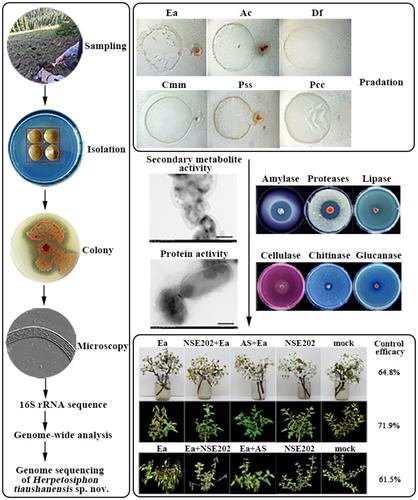当前位置:
X-MOL 学术
›
Pest Manag. Sci.
›
论文详情
Our official English website, www.x-mol.net, welcomes your
feedback! (Note: you will need to create a separate account there.)
A novel gliding filamentous bacterium Herpetosiphon tianshanensis sp. nov. NSE202 is a promising biocontrol agent for fire blight
Pest Management Science ( IF 3.8 ) Pub Date : 2025-05-28 , DOI: 10.1002/ps.8933
Jian Han 1 , Wen Lv 1 , Wenbo Ji 1 , Ruiyue Wang 1 , Ming Luo 1 , Benzhong Fu 1
Pest Management Science ( IF 3.8 ) Pub Date : 2025-05-28 , DOI: 10.1002/ps.8933
Jian Han 1 , Wen Lv 1 , Wenbo Ji 1 , Ruiyue Wang 1 , Ming Luo 1 , Benzhong Fu 1
Affiliation

|
BACKGROUNDFire blight (Erwinia amylovora ), a devastating bacterial disease, has posed significant challenges to apple and pear production for more than a century. In recent years, the spread of fire blight to China via Xinjiang has heightened concerns among planters and government authorities, particularly given the region's distinct geography and climate, underscoring the urgent need for innovative biocontrol strategies.RESULTSThis study introduced a predatory bacterium, Herpetosiphon tianshanensis sp. nov. NSE202, isolated from natural forest soil in Xinjiang, China, that could be a new type of promising biological control agent for the management of fire blight. Strain NSE202 differs from the five other reported Herpetosiphon species in terms of its physiological characteristics and genomic composition. Using morphological, 16S ribosomal RNA gene and whole‐genome analysis, the NSE202 strain was assigned to H. tianshanensis sp. nov. Strain NSE202 demonstrated strong predatory capability against Erwinia amylovora (Ea) in vitro . The biocontrol capacity of NSE202 was assayed on isolated inflorescences of fragrant pear and biennial potted pear seedlings under greenhouse conditions. The protective control efficacy of NSE202 was 64.8% in the inflorescences assay. Bacterial spraying of NSE202 significantly reduced the incidence anddisease index on pear seedlings with protective and therapeutic control efficacies of 71.9% and 61.5%, respectively. Strain NSE202 demonstrated stable colonization on pear blossoms and twigs under greenhouse conditions. The pathogen population was suppressed significantly in planta treated with NSE202, as shown by colony counts on plates, scanning electron microscopy, and quantitative polymerase chain reaction analysis. Further investigation demonstrated that secondary metabolites of strain NSE202, collected via macroporous resin, and extracellular proteins, precipitated using ammonium sulfate, had pronounced lytic activity against the fire blight pathogen. In addition, certain lipases, glycoside hydrolases, and peptidases secreted by strain NSE202 may contribute significantly to the predation process. These findings suggest that such components may serve as promising biocontrol factors.CONCLUSIONSThe discovery of H. tianshanensis sp. nov. NSE202 provides a new and promising strategy for combating fire blight. The isolates’ multiple capacities to colonize and exert antagonistic effects against Erwinia amylovora makes them highly promising candidates for an integrated biological solution. © 2025 Society of Chemical Industry.
更新日期:2025-05-28


















































 京公网安备 11010802027423号
京公网安备 11010802027423号